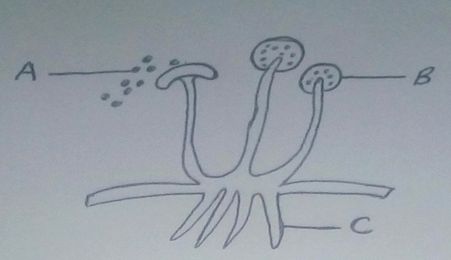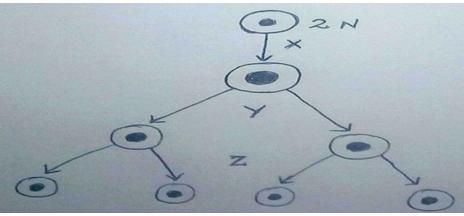 Get premium membership
Get premium membership and access revision papers with marking schemes, video lessons and live classes.
Form 4 Biology Mid Term 1 Examination 2023
Class: Form 4
Subject: Biology
Level: High School
Exam Category: Form 4 Mid Term Exams
Document Type: Pdf
Views: 848
Downloads: 21
Exam Summary
Name:…………………………………………………………adm:…………………….Class:………………
MIDTERM EXAMS
TERM 1 2023
BIOLOGY
FORM 4
TIME: 2HRS
INSTRUCTIONS:Answer all the questions in the spaces provided after the question.
1. A set of triplets,two of whom were identical were separated at birth and brought up by different families.when they were 19 years old,the data below were recorded.

a) Name two girls who were identical twins (2mks)
b) State two reasons why these two girls were different from each other in any of the three ways shown in the table (2mks)
2. outline the stages of metamorphosis in (2mks)
i. A cockroach
ii. b) A housefly
3. differentiate between epigeal and hypogeal type of germinations (2mks)
4. a)giving one example in each case, distinguish between continuous and discontinuous variations. (2mks)
5. if a woman cannot roll her tongue marries a man who is a tongue roller but is the son of a non-roller father, what would be the chances of them producing a non-roller child(ability to roll the tongue is dominant to non-rolling. Let R be gene for tongue rolling. (5mks)
6. State any three types of placentation exhibited by ovules in an ovary (3mks)
7. Study the figure below which represents a mature bread mould

i)Name structures A, B and C (3mks)
8.In a certain species of plants, the gene for red flowers is co dominant to the gene of white flowers. In one experiment of such plants, all F1 plants had pink flowers.
a) Using appropriate letter symbols, work out the genotypes of the F1 offsprings (4mks)
b) If one of the F1 offsprings who crossed with a white parent, what would be the phenotypic ratio of their offspring? (4mks)
c) What type of the cross is shown by the set up in (b) (4mks?)
9.State four biotic inter-relationships in an ecosystem (4mks)
10. The following living organisms have been observed in an isolated island; rats, insects, tortoise, snakes, grasses and birds. Construct four possible food chains each consisting of four organisms (4mks)
11 a).Name the cell division that produces the gametes (1mk)
b) From the cell division you have named above in (a) above, State the chromosome constitution of the gametes (1mk)
12. State the main classes of phylum chordata (5mks)
13. The chart below shows the number of chromosomes before and after cell division and fertilization in an animal.

a) What type of cell division takes place at Y and Z (2mks)
b) Where in the body of the female does Z occur? (1mk)
14. Name three types of chromosomal mutations (3mks)
15. a) What is the role of the vascular bundles in plant nutrition? (2mks)
b) To which class does an animal with two body parts and four pair of legs belongs? (1mk
C) State 3 importance of osmosis in plants (3mks)
d) Why is oxygen important in the process of active transport in cells? (1mk)
16. a) Give two reasons why accumulation of lactic acid during vigorous exercise lead to an increase in heart beat (2mks)
b)A person whose blood group is AB requires a blood tranfusion .Name the blood groups of the donors(1mk)
c) Adult elephants flap their ears twice as much as their calves in order to cool their bodies when it ishot, Explain (2mks)
d) Name the blood vessel that transports blood from; (2mks)
i) Small intestines to the river
ii) Lungs to the heart
17. a) Name the bacteria found in root nodules of leguminous plants (1mk)
b) What is the role of bacteria named in (a) above? (1mk)
c) Name the causative agent of typhoid (1mk)
18. (a) Name two sex-linked-traits in human (2mks)
b) How is parenchyma tissue adapted to its function? (2mks)
c) State the term referring to fruit formation without fertilization (1mk)
d) Other than Carbon (IV)oxide, name other product of anaerobic respiration (2mks)
19.a) Name the class in the phylum Arthropoda which has the largest number of individuals (1mk)
b) Give three factors that determine the amount of energy a human requires in a day (3mks)
c) Name three process in human body in which homeostasis is involved (3mks)
d) State three factors that affect enzymatic activities (3mks)
20. a) State the functions of the following cell organelles
i)Ribosomes
ii)Lysosomes
b) State the functions of the following partsof a light microscope
i) Objective lens
Ii) Diaphragm
c) Pregnancy continues if the ovary of an expectant mother is removed after four months. Explain (2mnks)
d) Other than using the quadrat give 3 other methods of estimating population of organisms (3mks)
21a) Name two dental diseases (2mks)
b) State two functions of saliva (2mks)
c) State one economic importance of each of the following plant excretory products (3mks)
i) Tannin
ii) Quinine
iii)Caffeine
More Examination Papers